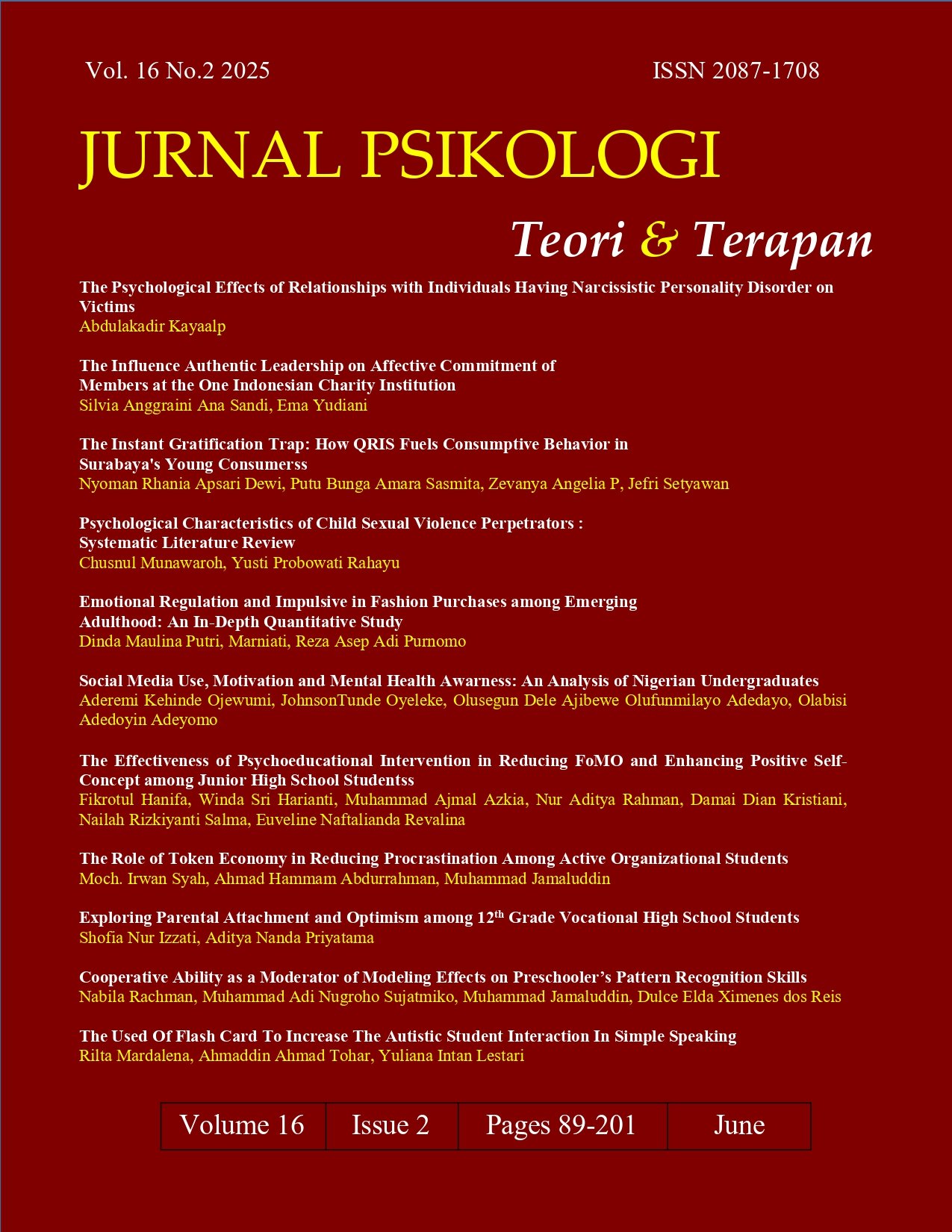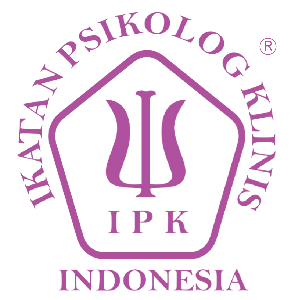The Psychological Effects of Relationships with Individuals Having Narcissistic Personality Disorder on Victims
DOI:
https://doi.org/10.26740/jptt.v16n02.p89-97Keywords:
Emotional manipulation narcissistic victims, narcissistic personality disorder, psychological effects, romantic relationshipsAbstract
Background: Narcissistic Personality Disorder (NPD) is characterized by excessive self-admiration, a need for validation, and a lack of empathy, often leading to emotionally harmful relationship patterns. Objective: This study aims to explore the psychological effects experienced by individuals who have been in romantic relationships with partners diagnosed with NPD. Method: A qualitative approach was adopted using purposive sampling to select participants who had been in long-term relationships with NPD individuals. Data were collected through in-depth interviews and thematically analyzed. Results: Findings indicate that NPD partners typically begin relationships with intense idealization, which gradually shifts to criticism, manipulation, and emotional abuse. Participants reported emotional exhaustion, diminished self-worth, and symptoms resembling post-traumatic stress. Conclusion: The study emphasizes the lasting psychological damage caused by such relationships, the need for strong social support systems during recovery, and the importance of raising awareness and providing psychological interventions. Further empirical research is encouraged to develop coping strategies and support mechanisms.
Abstrak
Latar Belakang: Gangguan Kepribadian Narsistik (NPD) ditandai dengan kekaguman diri yang berlebihan, kebutuhan akan validasi, dan kurangnya empati, yang seringkali mengarah pada pola hubungan yang merugikan secara emosional. Tujuan: Penelitian ini bertujuan untuk mengeksplorasi dampak psikologis yang dialami individu yang pernah menjalin hubungan romantis dengan pasangan yang didiagnosis NPD. Metode: Pendekatan kualitatif digunakan dengan teknik purposive sampling untuk memilih partisipan yang pernah memiliki hubungan jangka panjang dengan individu NPD. Data dikumpulkan melalui wawancara mendalam dan dianalisis secara tematik. Hasil: Temuan menunjukkan bahwa pasangan dengan NPD biasanya memulai hubungan dengan idealisasi berlebihan yang kemudian berubah menjadi kritik, manipulasi, dan kekerasan emosional. Partisipan melaporkan kelelahan emosional, penurunan harga diri, dan gejala mirip stres pascatrauma. Kesimpulan: Studi ini menyoroti kerusakan psikologis jangka panjang akibat hubungan tersebut, pentingnya dukungan sosial selama pemulihan, serta perlunya intervensi psikologis dan peningkatan kesadaran masyarakat. Penelitian lanjutan dianjurkan untuk mengembangkan strategi coping dan sistem dukungan yang efektif.
References
Abramson, K. (2014). Turning up the lights on gaslighting. Philosophical Perspectives, 28, 1–30. https://www.jstor.org/stable/26614542
Ataman, A., & Yalçınkaya, A. Ö. (2024). How “dark” is the dark triad in romantic relationships: A meta-analytic review of the relationship between the dark triad and infidelity. Psihologija, (00), 15–15. https://doi.org/10.2298/psi230920015a
Aydın, A., & Yavuzer, N. (2022). Narsisistik kişilik yapılanmasında yakın ilişkiye yönelik eğilimlerin incelenmesi. International Journal of Economics Administrative and Social Sciences, 5(1), 1–20. http://ijeass.gedik.edu.tr/tr/pub/issue/71352/1147254
Babcock, J. C., & Graham, K. H. (1997). Can batterers be empathic? Effects of abuse history and treatment. Journal of Interpersonal Violence, 12(3), 341–354. https://doi.org/10.1177/088626097012003007
Bachar, E., Hadar, H. M., & Shalev, A. Y. (2005). Narcissistic vulnerability and the development of PTSD: A prospective study. The Journal of Nervous and Mental Disease, 193(11), 762–765. https://doi.org/10.1097/01.nmd.0000185874.31672.a5
Braun, V., & Clarke, V. (2006). Using thematic analysis in psychology. Qualitative Research in Psychology, 3(2), 77–101. https://doi.org/10.1191/1478088706qp063oa
Bursten, B. (1973). Some narcissistic personality types. The International Journal of Psychoanalysis, 54(3), 287–300. https://psycnet.apa.org/record/1974-22989-001
Buss, D. M., Gomes, M., Higgins, D. S., & Lauterbach, K. (1987). Tactics of manipulation. Journal of Personality and Social Psychology, 52(6), 1219–1229. https://doi.org/10.1037/0022-3514.52.6.1219
Büyük, A., & Kaya Cicerali, L. (2021). Evli bireylerin aldatma eğilimi ile büyüklenmeci narsisistik kişilik özellikleri arasındaki ilişkinin incelenmesi. Opus International Journal of Society Researches, 18(42), 5230–5249. https://doi.org/10.26466/opus.936933
Campbell, W. K., & Foster, C. A. (2002). Narcissism and commitment in romantic relationships: An investment model analysis. Personality and Social Psychology Bulletin, 28(4), 484–495. https://doi.org/10.1177/0146167202287006
Campbell, W. K., Rudich, E., & Sedikides, C. (2002). Narcissism, self-esteem, and the positivity of self-views: Two portraits of self-love. Personality and Social Psychology Bulletin, 28, 358–368. https://doi.org/10.1177/0146167202286007
Cohen, J. A. (1981). Theories of narcissism and trauma. American Journal of Psychotherapy. https://doi.org/10.1176/appi.psychotherapy.1981.35.1.93
Costin, A. (2020). Social and educational implications regarding the raising of children in narcissistic families: Theoretical approach. Educația Plus, 27(2), 50–62. https://www.ceeol.com/search/article-detail?id=906744
Çelik, C., Seçen, A., & Erden, G. (2021). Özgül öğrenme güçlüğü olan çocukların benlik saygıları ile ailelerinin duygu sosyalleştirme tepkilerinin psikolojik iyi oluş üzerindeki etkisi. Ankara Medipol Üniversitesi.
Demirci, İ., & Ekşi, F. (2017). Büyüklenmeci narsisizmin iki farklı yüzü: Narsistik hayranlık ve rekabetin mutlulukla ilişkisi. Marmara Üniversitesi Atatürk Eğitim Fakültesi Eğitim Bilimleri Dergisi, 46(46), 37–58. https://doi.org/10.15285/maruaebd.330008
Dixon, L., & Graham-Kevan, N. (2011). Understanding the nature and etiology of intimate partner violence. Clinical Psychology Review, 31(7), 1145–1155. https://doi.org/10.1016/j.cpr.2011.07.001
Elaad, E., Hanania, S. B., Mazor, S., & Zvi, L. (2020). The relations between deception, narcissism and self-assessed lie- and truth-related abilities. Psychiatry, Psychology and Law, 27(5), 880–893. https://doi.org/10.1080/13218719.2020.1751328
Ellis, H. (1927). The conception of narcissism. Psychoanalytic Review, 14, 129–153. https://psycnet.apa.org/record/1927-01712-001
Ertürk, Y. D., & Eray, T. E. (2016). Fenomenolojik bir kavram olarak kendilik ve sosyal ağlarda kendilik sunumu ile narsistik eğilimler ilişkisi: İletişim Fakültesi (İ.Ü.İ.F.) öğrencileri üzerine bir ön çalışma. Intermedia International E-Journal, 3(4), 12–29. https://dergipark.org.tr/tr/pub/intermedia/issue/33912/375354
Exline, J. J., Baumeister, R. F., Bushman, B. J., Campbell, W. K., & Finkel, E. J. (2004). Too proud to let go: Narcissistic entitlement as a barrier to forgiveness. Journal of Personality and Social Psychology, 87(6), 894–912. https://doi.org/10.1037/0022-3514.87.6.894
Forsyth, D. R., Banks, G. C., & McDaniel, M. A. (2012). A meta-analysis of the dark triad and work behavior: A social exchange perspective. Journal of Applied Psychology, 97(3), 557–579. https://doi.org/10.1037/a0025679
Freud, S. (1914). On narcissism.
Funk, R. (2019). The narcissistic character.
Grant, B. F., et al. (2008). Prevalence, correlates, disability, and comorbidity of DSM-IV borderline personality disorder: Results from the Wave 2 National Epidemiologic Survey on Alcohol and Related Conditions. Journal of Clinical Psychiatry, 69(4), 533.
Holt, L. J., & Pincus, A. L. (2017). The role of narcissism in close relationships: A review of the literature. Personality and Individual Differences, 115, 1–5.
Hunyady, O., Josephs, L., & Jost, J. T. (2008). Priming the primal scene: Betrayal trauma, narcissism, and attitudes toward sexual infidelity. Self and Identity, 7(3), 278–294. https://doi.org/10.1080/15298860701620227
Iğdırlı, Z. (2023). Romantik ilişkilerdeki aldatma davranışını narsistik kişilik eğilimi çerçevesinde değerlendirmeye dayalı kısa bir derleme. Balkan & Near Eastern Journal of Social Sciences (BNEJSS), 9(2).
Karaaziz, M., & Atak, İ. E. (2013). Narsisizm ve narsizmle ilgili araştırmalar üzerine bir gözden geçirme. Nesne Psikoloji Dergisi, 1(2), 44–59. https://doi.org/10.7816/nesne-01-02-03
Karandashev, V. (2019). Idealization and romantic beliefs in love. In Cross-Cultural Perspectives on the Experience and Expression of Love (pp. 43–56). Springer. https://doi.org/10.1007/978-3-030-15020-4_4
Karslı, T. A., & Anlı, İ. (2010). Effects of healthy and defensive narcissism on locus of control and viewpoint to “trauma experience.” Procedia - Social and Behavioral Sciences. https://doi.org/10.1016/j.sbspro.2010.07.133
Kocsis, R. N. (2013). Book review: Diagnostic and statistical manual of mental disorders (DSM-5).
Korkmaz, S. (2022). Romantik ilişkilerde narsizm ve manipülasyon ilişkisi. Proceeding Book, 271, 1–5.
Korkmaz, S. (2023). Üniversite öğrencilerinin kariyer uyumluluğu ve kariyer iyimserliği ile kariyer kararı öz-yetkinliği ve algılanan anababa tutumu arasındaki ilişkiler (Master's thesis, Başkent Üniversitesi Eğitim Bilimleri Enstitüsü).
Mento, C., et al. (2023). Psychological violence and manipulative behavior in couple: A focus on personality traits. Journal of Mind and Medical Sciences, 10(2). https://doi.org/10.22543/2392-7674.1399
Miller, J. D., Widiger, T. A., & Campbell, W. K. (2010). Narcissistic personality disorder and the DSM-V. Journal of Abnormal Psychology, 119(4), 640-649. https://doi.org/10.1037/a0019529.
Morrison, A. P., & Stolorow, R. D. (2014). Shame, narcissism, and intersubjectivity. In The Widening Scope of Shame (pp. 63–87). Routledge.
Nurkan, E. (2020). Yetişkinlerin bağlanma stilleri ile duygusal zekâ, depresyon, anksiyete ve stres düzeyleri arasındaki ilişkinin incelenmesi (Master's thesis, İstanbul Sabahattin Zaim Üniversitesi, Sosyal Bilimler Enstitüsü).
Özçetin, A., Maraş, A., Ataoğlu, A., & İçmeli, C. (2008). Deprem sonucu gelişen travma sonrası stres bozukluğu ile kişilik bozuklukları arasında ilişki. Düzce Medical Journal, 10(2), 8–18. https://dergipark.org.tr/en/pub/dtfd/issue/48264/610974
Raskin, R., & Terry, H. (1988). A principal-components analysis of the narcissistic personality inventory and further evidence of its construct validity. Journal of Personality and Social Psychology, 54(5), 890-902. https://sys.re/files/docs/psychology/raskin.pdf
Ring, N. (2024). The effects of narcissistic abuse on the non-narcissistic partner in a romantic relationship (Order No. 31766019). ProQuest Dissertations & Theses Global. https://www.proquest.com/dissertations-theses/effects-narcissistic-abuse-on-non-partner/docview/3145318151/se-2
Ronningstam, E. (2017). Intersect between self-esteem and emotion regulation in narcissistic personality disorder: Implications for alliance building and treatment. Borderline Personality Disorder and Emotion Dysregulation, 4(3). https://doi.org/10.1186/s40479-017-0054-8
Rozenblatt, S. (2002). In defense of the self: The relationship of self-esteem and narcissism to aggressive behavior (Order No. 3049635). ProQuest Dissertations & Theses Global. https://www.proquest.com/dissertations-theses/defense-self-relationship-esteem-narcissism/docview/305513763/se-2
Sengkey, M. M., & Illahibaccus-Sona, S. B. (2024). Psychological and behavioral impacts of early adult women victims of gaslighting behavior in romantic relationships. Inspira: Indonesian Journal of Psychological Research, 5(1), 38–48. https://doi.org/10.32505/inspira.v5i1.7277
Tarım, B. (2019). Yas yaşantısında travma sonrası büyüme (Master's thesis, Sosyal Bilimler Enstitüsü).
Wurst, S. N., et al. (2017). Narcissism and romantic relationships: The differential impact of narcissistic admiration and rivalry. Journal of Personality and Social Psychology, 112(2), 280–306. https://doi.org/10.1037/pspp0000113
Zadeh, P. K. (2017). Theoretical considerations for understanding the nature of relational trauma and loss of interpersonal self-esteem of women in narcissistic relationships [Doctoral dissertation, Antioch University]. OhioLINK ETD Center. http://rave.ohiolink.edu/etdc/view?acc_num=antioch1503534979668914
Downloads
Published
How to Cite
Issue
Section
License
Copyright (c) 2025 Abdulkadir Kayaalp

This work is licensed under a Creative Commons Attribution 4.0 International License.
Authors who publish in this journal agree to the following terms:
Copyright in any article is held by the author.
The author grants the journal, publication rights with the work simultaneously licensed under a Creative Commons Attribution License that allows others to share the work with an acknowledgment of the work's authorship and initial publication in this journal.
Authors may enter into separate, additional contractual arrangements for the non-exclusive distribution of the journal's published version of the work (e.g., posting it to an institutional repository or publishing it in a book), with an acknowledgment of its initial publication in this journal.
Authors are permitted and encouraged to post their work online (e.g., in an institutional repository or on their website) prior to and during the submission process, as this can lead to productive exchanges, as well as earlier and greater citation of published work.
 Abstract views: 1388
,
Abstract views: 1388
, PDF Downloads: 1196
PDF Downloads: 1196


















